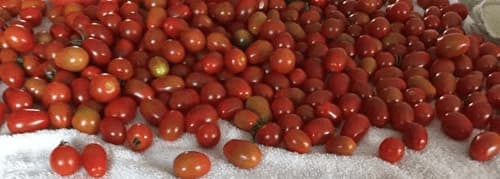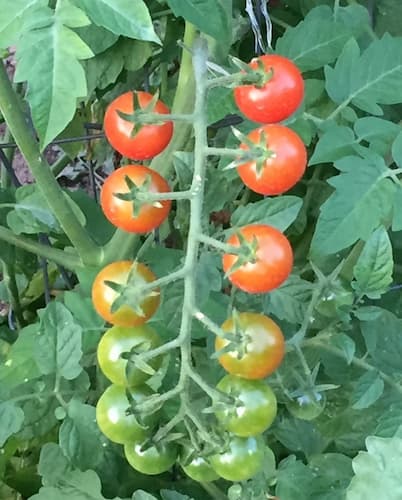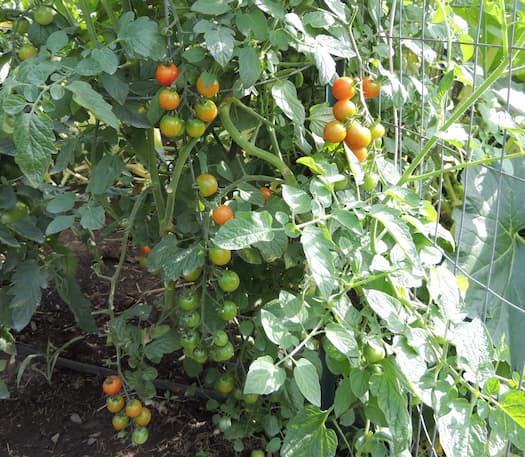How to Grow Cherry Tomatoes

Cherry Tomatoes, Sweet, Bite-Sized Sweet Treats
Sweet, bite-sized, pop in your mouth cherry tomatoes, are a favorite in the home garden. Many of the cherry tomatoes that are harvested, never reach your kitchen, as they are eaten right in the garden. Make sure to plant them at the edge of your garden, so kids can munch on this healthy treat as they pass by, without tramping through the garden to reach them. Our vegetable gardens would not be complete without them. Follow our guide on how to grow cherry tomatoes, to grow healthy, high-yielding plants.
When cherry tomatoes ripen, there’s nothing quite like it. The indeterminate plants produce of profusion of small tomatoes, from mid-summer to fall. They come in a variety of colors, with red being the most popular. You can also find orange, yellow, and chocolate varieties.
Growing Tip: Plant cherry tomato plants at the edge of the garden. Kids and adults will come right up for a tasty, right from the garden treat.
How to Start CherryTomatoes from Seeds
Certainly, you can buy seedlings plants from your local garden store. But, why let the garden stores have all the fun. So. plan to start your own cherry tomato plants indoors.
Tomato plants are usually started indoors. Planting tomato seeds is an exciting time. It is one of the very first gardening projects of the year. After a long winter, you are itching to get your hands back into some “dirt”.
Begin starting tomato seeds indoors in small containers, eight to ten weeks before the last frost date for your area. Sow tomato seeds about 1/8″ inch deep, using seed starting soil. Seeds will sprout in 10-14 days, depending upon soil temperature. Sprouting tomato seeds is quicker and more productive when using a heated germination mat.
As soon as the seedlings emerge, they need full sunlight to grow sturdy. Lack of sunlight causes the plants to grow “leggy”. Use grow lights to supplement the amount of available sunlight.
Tip: To help your plants grow sturdy, place a small fan on low nearby. Or, lightly brush the tops of the plants with your hands a couple of times each day.

How to Grow Cherry Tomatoes - Season Long Care
Grow cherry tomatoes just like any tomato variety. Like other tomato plants, they grow best in full sun and rich garden soil.
It is best to start your cherry tomato plants indoors. Plant cherry tomato seeds in small containers, eight to ten weeks before the last frost date for your area. You can also start seeds in a cold frame.
Just before planting seedlings in your garden, “harden them off” by bringing them outside during the daytime and for increasing hours, until you are leaving them out overnight. Use of a cold frame is recommended, but not a requirement. If frost is predicted, bring them indoors.
On planting day, pour liberal amounts of water with a soluble liquid fertilizer on them. Plant them in the garden carefully. To minimize transplant shock, avoid disturbing the roots. Normal spacing is 24 ” apart, in rows 30″ to 36″ apart.
Fertilize plants, regularly. Early fertilizer applications should be high in nitrogen. As soon as flower buds begin to appear, switch to fertilizers that are higher in Phosphorus and Potassium. Too much Nitrogen fertilizer results in lots of lush green leaves, and little fruit. A fertilizer specifically formulated for tomatoes will help to maximize your crop.
Keep your cherry tomato plants well-watered. Deep watering is preferable, over more frequent, light watering. You want moisture to go deep to all the roots of the plant. Water directly to the roots. Keep water off the leaves if at all possible. Tomatoes are susceptible to plant disease that grows in wet, humid conditions.
Caging or staking your cherry tomato plants, is recommended. We consider it a must. You can also plant them next to a fence, and tie the branches to the fence as they grow.
Tomato Cages and Staking Plants
Tomato Cages and Staking – Maximize your crop, and minimize disease and insect damage, by staking or caging tomato plants. Cherry tomato plants are an indeterminate variety. A healthy plant will grow five to six feet during the growing season. Staking or cages rewards you with more tomatoes. The fruit will be cleaner, as they will not be sitting on the soil. More on staking tomatoes.

Plant Maturity and Days to Harvest
Cherry tomato plants grow at about the same speed as other tomato plants. The small fruit takes less time to grow and ripen. The fruit ripens about 70 days after you transplant the seedlings in the garden.
Cold and hot spells affect fruit development and growth. Fruit set does not occur below 55 degrees or above 90 degrees Fahrenheit.
Cherry tomato plants are prolific producers. To maximize the harvest, pick fruit continuously as it ripens. This promotes new flowering and fruit set.
Insects and Pests
Tomatoes experience insect problems with cutworms and a few other garden pests. Also, if not staked or caged, snails and slugs will munch on the ripening fruit.
Deer will nip the young, tender growing tips of the plants.
Did you Know? Tomato plants emit a mild toxin that discourages many small insects from bothering them. This toxin can also cause skin itching and irritation.
Tip: Borage plants can be used as companion plants, to deter Tomato hornworms
Did you Know? Tomato plants (not the fruit) are used to make an organic insect repellent. See Tomato “Juice” Spray
How to Grow Cherry Tomatoes - Plant Disease
Several plant problems can arise, usually in the mid-summer heat and humidity. Blights and fungus infections can occur in high humidity. Early treatment with fungicides is effective. Spacing plants too close cuts down air circulation and promotes disease.
Blossom end rot can also affect the fruit. This is a round, brown, indented spot on the bottom of the tomato. It is caused by either uneven watering or a lack of calcium in the soil. More on Blossom End Rot.
Tip: Do not water at night if possible, in hot and humid weather if possible. Moisture and humidity combined with high temperatures promote plant diseases. If possible, water at the roots.
Tomato Plant Problems Causes and cures for many plant problems
Plant Hardiness
Tomatoes like it hot! They will die if exposed to frost. Make sure to plant them after the last frost.
Tip#1: Cover your young seedling if frost is predicted. A simple and easy cover for small seedlings is to buy large or extra large plastic disposable cups. Place them over the seedling at dusk, and remove them in the morning. There is usually little or no wind on nights with frost, so they are not easily tipped over.
Tip#2: If you get a light frost overnight and you did not cover up your plants. Go out early before the sun rises, and spray your plants with the garden hose. This melts the ice off the plants and may save them.
Harvesting Cherry Tomatoes
Harvest cherry tomatoes anytime from when they begin to turn pink, to when they fully ripen into a bright red, color.
Importantly, pick all fruit as it ripens or just before. With healthy prolific plants, this can be a chore. However, unpicked tomatoes rot, turning messy and smelly.
Store ripe grape tomatoes on a countertop, or any cool, dry location. Also, do not put them in the refrigerator.
Garden Tomato Recipes
May we suggest:
Sauteed Cherry Tomatoes – And, you can use grape tomatoes with this recipe,too.
Fried Green Tomatoes – It’s a great way to use up those end-of-season tomatoes that didn’t ripen before frost.
When making large amounts of juice or sauce, you will need a tomato strainer and sauce maker, to easily remove seeds and skin. See Tomato Strainers.
How to Grow Cherry Tomatoes - Related Articles
On the Light Side: See Tomato Trivia
Tomato Mania – In-depth information and advice from Garden Hobbies
Problems with Tomatoes – To begin with, an ounce of prevention is worth a pound of cure
Please support our site. Shop for:
- rmmatthews100@hotmail.com
- 585-721-6528
- Rochester, NY
©1999-2024 GardenersNet.Com, All Rights Reserved

